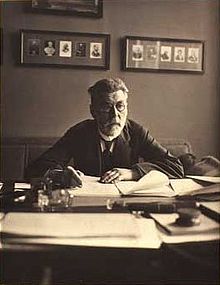Asger Skovgaard Ostenfeld
Asger Skovgaard Ostenfeld (born October 13, 1866 in Jutland , † September 17, 1931 in Copenhagen ) was a Danish civil engineer.
Ostenfeld studied civil engineering at the Polytechnic in Copenhagen , graduating in 1890. He worked for six years as a civil engineer while he was also an assistant for road and hydraulic engineering at the Polytechnic in Copenhagen. In 1894 he became a lecturer and in 1894 professor for applied mechanics, from 1905 for structural engineering and steel construction. After his retirement in 1926, he became head of the building construction laboratory, which he remained until his death.
He was in Vienna for a long time and published a number of works on reinforced concrete structures in the magazine of the Austrian Architects and Engineers Association between 1896 and 1900. Several textbooks on statics and elasticity theory in German followed.
Karl-Eugen Kurrer called his book on the deformation method the most important pioneering work in the consolidation phase of structural engineering. He further developed the deformation size method ( path size method ) so that it could be applied in practice to frame structures (inspired by a work by his student Axel Bendixsen, which was published in 1914). Before that, at the end of the 19th century, Germany had used the force size method by Heinrich Müller-Breslau for the calculation of frame structures, in competition with the deformation size method by Christian Otto Mohr . The deformation method became the preferred method for the finite element method in the 1960s , which, together with the advent of the computer, fulfilled a hope that Ostenfeld had formulated in 1926 to make complex problems accessible in this way. Ostenfeld was also one of the pioneers of dimensioning in reinforced concrete construction, who found their way into Denmark in 1891 with the establishment of a subsidiary of Beton- und Monierbau in Copenhagen. As early as 1896 he advocated the consideration of the tensile stress in the reinforced concrete design (based on experiments by Grut and Nielsen in Denmark 1895/96) and assumed that the steel on the surrounding concrete had an influence on the tensile strength of the concrete (proven by experiments by Armand Considère 1898). In the dimensioning, however, he neglected this as incalculable, as did the approaches of other engineers.
He was an honorary doctor of the German Technical University in Prague . He was an honorary member of the Danish Association of Engineers (1930) and a member of the Royal Swedish Academy of Engineering and the Mazaryk Academy in Prague, as well as the commander of the Order of Dannebrog .
In Scandinavia he was a member of various juries for bridge building competitions.
His son Christen Ostenfeld (1900–1976) was the founder of the largest Scandinavian engineering company COWI .
Fonts
- For the calculation of Monier constructions, magazine of the Austrian. Architects and Engineers Association, Volume 50, 1898, pp. 22-25
- Technical statics, Leipzig 1904
- Technical elasticity theory, 1898 (Danish edition: Teknisk Elasticitetslære: Grundlag for Forelæsninger paa Polyteknisk Læreanstalt, Copenhagen 1898, archive )
- Iron structures in building and bridge construction, 1906, 1909, 1912
- Reinforced concrete bridges 1917
- Calculation of statically indeterminate systems using the deformation method, Der Eisenbau, Volume 12, 1921, pp. 275–289
- The deformation method, Springer 1926
literature
- Karl-Eugen Kurrer : The History of the Theory of Structures. Searching for Equilibrium , Ernst & Sohn 2018, p. 806ff and p. 1041 (biography), ISBN 978-3-433-03229-9 .
Individual evidence
- ^ Karl-Eugen Kurrer, The development of the deformation method, in: Antonio Becchi u. a., Essays on the history of mechanics, Birkhäuser 2003, p. 83
- ↑ Thomas Jürges, The Development of Bending, Shear and Deformation Design in Reinforced Concrete Construction and Its Application in Structural Science, Dissertation, RWTH Aachen 2000, pp. 38ff pdf
| personal data | |
|---|---|
| SURNAME | Ostenfeld, Asger Skovgaard |
| BRIEF DESCRIPTION | Danish civil engineer |
| DATE OF BIRTH | October 13, 1866 |
| PLACE OF BIRTH | Jutland |
| DATE OF DEATH | September 17, 1931 |
| Place of death | Copenhagen |
